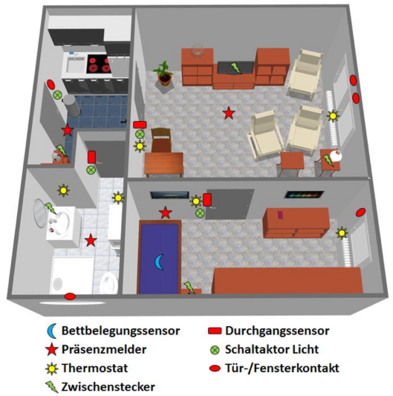GerMobiS
GerMobiS
Geriatrisches Mobilitätsassessment mit tragbaren Sensoren (GerMobiS)
 For a systematic assessment of the functionality of older people time and labor-saving methods are needed. Portable sensor technology, especially in the form of inertial measurement units (IMUs), could allow an automated assessment of individual mobility in old age. Against this background, data already collected from the two completed projects GAL NATARS and Otago teA are to be evaluated in GerMobiS.
For a systematic assessment of the functionality of older people time and labor-saving methods are needed. Portable sensor technology, especially in the form of inertial measurement units (IMUs), could allow an automated assessment of individual mobility in old age. Against this background, data already collected from the two completed projects GAL NATARS and Otago teA are to be evaluated in GerMobiS.
In GAL NATARS, the feasibility and acceptance of technical assistance systems in the home environment of geriatric patients with fractures due to falls was examined during following inpatient care. In Otago teA fall-prone subjects were observed with a domestic multi-component sensor system including a portable inertial sensor.
The change in the mobility of the participants was confirmed in both studies i.a. reviewed by the De Morton Mobility Index (DEMMI) and the Short Physical Performance Battery (SPPB). The aim of the study in the current project is to evaluate whether the performance of multiple geriatric assessments can be detected and mapped by close-to-body, portable IMUs and room-based sensors (light barriers, door contacts, present detectors). Compared to the standardized execution of the assessments, changes in mobility in a measurement continuum can be recorded more precisely by achieving higher measurement accuracy and by determining parameters such as walking speed and probability of occupancy in rooms that can not be collected using standard procedures. Thus, the evaluation of historical data is of particular importance in order to recognize at an early stage a threat to self-employment.
For this, the sensor datasets of both studies are analyzed. Basic motion patterns and detection algorithms for the individual assessment items (e.g., walking speed) are derived and mapped on the scales of the DEMMI and SPPB. The reproducibility of the sensor-derived assessments is checked and then compared with the results of the manual measurement. A statistical model that minimizes the forecasting error for the gold standard is sought. An automated survey of the mobility parameters described in everyday life allows a historical assessment of the functionality of geriatric patients.
Funding / Cooperations
The project is funded through the research pool of the Faculty of Medicine and Health Sciences (2017).
